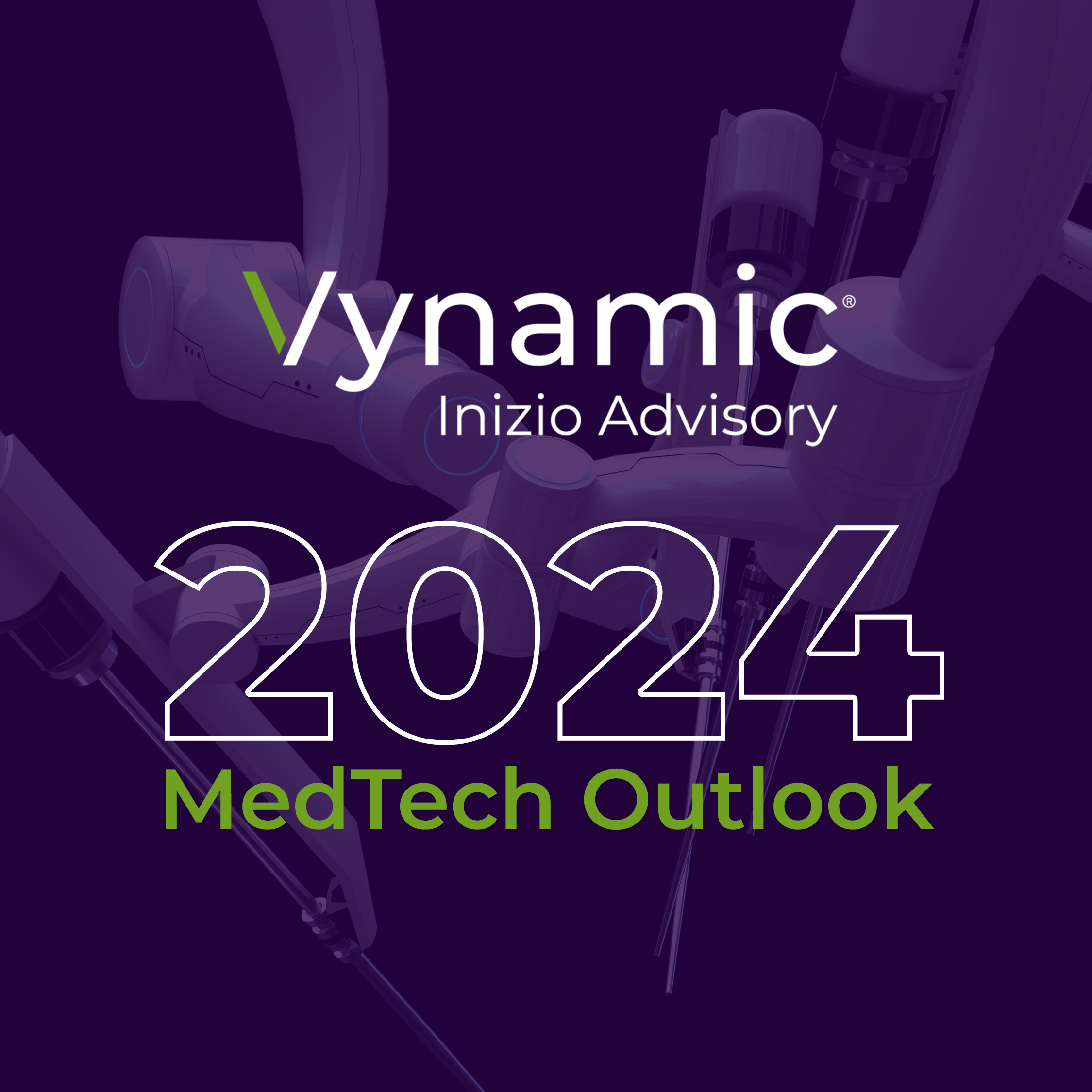2024 MedTech Outlook
In the fluid landscape of the health industry, technology stands at the forefront, essential for addressing the multitude of challenges and capitalizing on the opportunities that lie within the industry. Where the paths of health and technology intersect, we witness the emergence of innovative solutions ranging from the accessibility provided by telehealth services and the nuanced capabilities of health-monitoring wearables, to the predictive power of data analytics and the customized accuracy of individualized treatments. Spanning an extensive array of advancements, this exploration delves deeper into the vibrant domain of medical technology, or MedTech, spotlighting the trends that are defining its future.
MedTech encompasses an array of innovations that are revolutionizing the health industry, from the precision of robot-assisted surgeries and cutting-edge diagnostic tools, to pioneering implantable devices and expansive telehealth services. Even amid a year of formidable economic headwinds, MedTech remains a powerhouse of transformative progress in health technology.
As we draw closer to 2023’s close and gear up for what’s next, here are the latest standout trends in MedTech and their potential impacts.
Increase in research & development spend
As the flow of venture capital funding has diminished for many MedTech startups, a notable shift has been observed among the sector’s leading firms: an increased investment in Research & Development (R&D). Major players such as Edwards Lifesciences, Intuitive Surgical, and Johnson & Johnson are allocating a larger proportion of their revenue toward R&D initiatives, with Johnson & Johnson committing and average 16% of their net sales into R&D expenses.1 This strategy mirrors the targeted approach of mergers and acquisitions prevalent in the MedTech sector, channeling substantial R&D investments into critical fields such as cardiovascular, diabetes, orthopedics, and neuro-technologies.
Venture capital (VC) financing sat at $2.5B, the lowest since June 2015 for MedTech startups.2 – attributed to regulatory challenges with many startups and an over-investment in HealthTech during the COVID-19 pandemic. When VC funding was secured, it was focused primarily in generative AI and robotics (e.g. FemTherapeutics, Noah Medical, Distalmotion) and was in lower rounds. Simply stated, MedTech had a harder time signing deals and fundraising in 2023. Despite several deals happening, most were of a significantly smaller value than years past. The slowdown in VC activity can be attributed to inflation, higher interest rates, a frozen IPO market, and challenging financial health of health system end-markets. This will likely continue into 2024.
Remote patient monitoring (RPM)
As more and more care shifts to the home-based setting, MedTech companies are embracing integrated devices with both software and hardware components, enabling remote patient monitoring (RPM) for both patients and HCPs. This increasingly complements traditional treatments with implantable smart-devices or wearables enabling monitoring in settings outside the practice. RPM can even help alert mechanisms to notify healthcare providers when a patient’s vital signs or other parameters fall outside predefined normal ranges or when there is a significant change in the patient’s condition. This can enable timely intervention and care adjustments, as appropriate.
The RPM market is forecasted to reach $175.2B by 2027, up from $53.6B in 2022 (26.7% CAGR).3 This can largely be attributed to the broad benefits of these types of solutions from patients with chronic conditions like diabetes, hypertension, heart disease, patients requiring post-operative care, or elderly individuals who wish to age in place. This form of continuous monitoring may help healthcare providers make timely adjustments to treatment plans, reduce hospital readmissions, and can help with cost-reduction by optimizing resource allocation.
Spinoffs to expand access
Over the past year, several firms have shed portions of their business to re-focus their priorities as an organization. Aimed at simplifying and strengthening their core business, these firms are pursuing greater operational efficiencies and long-term value created by “going deep” in a targeted market.
This trend presented itself most clearly in the kidney care market, with a continued push to improve access at home, transplants, and preventative care. Baxter spun off their kidney care segment to create Vantive, while Medtronic & DaVita formed Mozarc. Kidney care was, in part, ripe for this type of re-focus due to recent focus from CMS to improve access to at-home treatment vs. the existing standard of care, treatment at dialysis centers. These new kidney-oriented organizations are well-poised to create comprehensive solutions that solve targeted and end-to-end needs of their patient populations, while creating leadership due to their respective legacies in the space.
Global regulation and policy shifts
MedTech devices lend themselves to frequent enhancements and/or refinements to reflect ever-evolving patient and healthcare professional (HCP) needs. With an increased volume of devices coming to market, regular refinements, and the introduction of artificial intelligence/machine learning (AI/ML) in the medical device space, a number of regulators across the globe have published new guidance over the past year.
Marking a significant shift for the first time in 16 years, the FDA has released new guidance regarding the submission process for products embedded with software. The updated framework pivots away from the traditional risk-based “levels of concern” to a new structure focused on “basic” and “enhanced” requirements. Numerous MedTech companies had already begun adapting to the guidelines based on preliminary drafts released in 2021. Those who had not made these changes found themselves facing a brisk timeline to comply over summer 2023, aligning with the FDA’s request for submissions in accordance with the new guidance starting August 13, 2023. Furthermore, the FDA issued draft guidance specifically for AI/ML-powered device functions. This proposed framework aims to expedite the enhancement of ML-DSFs (Machine Learning – Device Software Functions), thus enabling manufacturers to deliver updates to healthcare providers and patients more swiftly compared to the conventional marketing authorization pathway.
In the UK, the Medicines and Healthcare Products Regulatory Agency (MHRA) has suggested postponing the adoption of new medical device regulations for the Great Britain market until July 2025. This aims to ensure an ongoing safe supply of devices and ease transition to the new regulations, and emphasized the need to focus on patient safety. While in Europe, the implementation of new Medical Device Regulation (MDR) has also been delayed, raising concerns about review capacity. Many manufacturers are not sufficiently prepared to meet the robust requirements of the Medical Devices Regulation by the end of the current transition period. This delay was put in place to minimize supply and availability challenges across the EU Market as firms implement these new requirements.
Concentrated mergers and acquisitions
With the significant macroeconomic pressures of the past year, merger and acquisition (M&A) activities have slowed, with organizations being a bit more targeted with their investments than we’ve seen over the past few years. Overall, MedTech saw a lower number of deals in H123, 42 deals closed vs. 81 in FY22, 156 in FY21, 126 in FY20, 180 in FY19, and 224 in FY18.2 Similar to the driving forces of the spinoffs noted above, organizations are specifically aiming their investment in targeted areas that enhance their portfolio or drive innovation, and in-part de-risking some of their investment in new technologies through acquisition of assets that are well developed or established.
Recent M&A investments have been noted within MedTech in the orthopedic, diabetes, and cardiovascular markets as well as the surgical robotics market. For example, within orthopedics, noted investments were within capabilities supporting 3-D implant printing, robotics, and generative AI. With revenue projected to grow at 3.92% CAGR from $44.2B in 2023 to $53.6B in 2028 in the orthopedic market.4 While in diabetes, investment was focused on medical devices with smart technology for better monitoring, with revenue expected to reach $68.2B by 2032, growing at 11.3% CAGR.5
These M&A activities are primarily driven by the promise of bringing to market innovative solutions to meet patient and HCP needs, while attempting to get ahead of the competition and putting together an overall portfolio that makes sense for the firm to deliver against their core business. With any merger or acquisition, businesses don’t integrate overnight. It will be essential for these firms to invest in the integration of the new business to realize their operational efficiencies and maximize their ability to go to market effectively.
The landscape of MedTech and recent trends illustrate several broader trends emerging across the Health Technology sector. 2023 presented its fair share of headwinds, with several expected to continue into 2024, particularly those financial trends and the noted convergence of similarly focused organizations with the goal of delivering user or patient-centric solutions in the healthcare setting.
With the above trends in mind, MedTech firms will need to be able to communicate a specific, clear value proposition to remain competitive amidst the broad reduction in funding available across the industry. As MedTech firms explore potential “add-on” services or capabilities to their products or portfolios, the investment must fit their value prop and be complementary and capable of being integrated with existing solutions. Additionally, ability to demonstrate value quickly to gain and maintain access will be necessary to continue to drive the uptake of technologies like remote patient monitoring. Finally, with regulations changing and the abundance of data that is being generated across the industry, security and privacy for the patient is crucial, and so cybersecurity considerations must be addressed throughout the development lifecycle to remain compliant with evolving standards.
As MedTech and Health Technology organizations consider these trends, Vynamic supports clients in this space develop strategies and approaches to delivering solutions in a better way. Learn more about our Health Technology solutions, and contact us to find out how Vynamic can support you in planning and executing on these trends.
End notes:
- Taylor, N. P. Slump in medtech VC activity continues as inflation keeps investors on the sidelines. MedTech Dive. [Online]. Available from: https://www.medtechdive.com/news/pitchbook-medtech-investment-q1-2023/651233/. [Accessed 25 May 2023].
- Cairns, E. Medtech dealmaking grinds almost to a halt. Evaluate.com. [Online]. Available from: https://www.evaluate.com/vantage/articles/insights/ma/medtech-dealmaking-grinds-almost-halt. [Accessed 6 July 2023].
- Thompson, N. Medical Technology Trends for 2023: From sustainably to remote monitoring. Medical Device Network. [Online]. Available from: https://www.medicaldevice-network.com/sponsored/medical-technology-trends-for-2023-from-sustainably-to-remote-monitoring/. [Accessed 24 March 2023].
- Orthopedic devices – worldwide: Statista market forecast. (n.d.). [Online]. Available from: https://www.statista.com/outlook/hmo/medical-technology/medical-devices/orthopedic-devices/worldwide.
- Us. Diabetes devices market share is expected to climb 68.2 billion by 2032: 11.3% CAGR – Market.us analysis. GlobeNewswire News Room. Available from: https://www.globenewswire.com/en/news-release/2023/05/24/2675004/0/en/Diabetes-Devices-Market-Share-is-Expected-to-Climb-68-2-Billion-by-2032-11-3-CAGR-Market-us-Analysis.html. [Accessed 24 May 2023].

About Vynamic
Vynamic, an Inizio Advisory company, is a leading management consulting partner to global health organizations across Life Sciences, Health Services, and Health Technology. Founded and headquartered in Philadelphia, Vynamic has offices in Boston, Durham NC, New York, and London. Our purpose is simple: We believe there is a better way. We are passionate about shaping the future of health, and for more than 20 years we’ve helped clients transform by connecting strategy to action.
Through a structured, yet flexible delivery model, our accomplished leaders work as an extension of client teams, enabling growth, performance, and culture. Vynamic has been recognized by organizations like Great Place to Work and Business Culture Awards for being leaders and innovators in consulting, company culture, and health. Visit Vynamic.com to discover how we can help transform your
organization or your career.
Want to learn more? Get in touch!
Other insights.
Jump to a slide with the slide dots.
 Prathima Guniganti
Prathima Guniganti
POV: Ensuring AI-Powered Omnichannel Strategies Deliver Expected Results
Learn how to optimize AI-powered omnichannel strategies for better engagement, data governance, and measurable results in life sciences
Read more Mindy McGrath
Mindy McGrath
The Case for Strategic Transformation: An Executive Conversation with Vynamic’s Leaders
Discover how healthcare orgs drive sustainable change through strategy, leadership, and execution—insights from Vynamic leaders.
Read moreU.S. Federal Health Agency Layoffs Pose Strategic Risk and Disruption to Life Sciences
Layoffs at U.S. health agencies, IRA, and budget cuts disrupt pharma—learn how life sciences can adapt and stay resilient.
Read more

